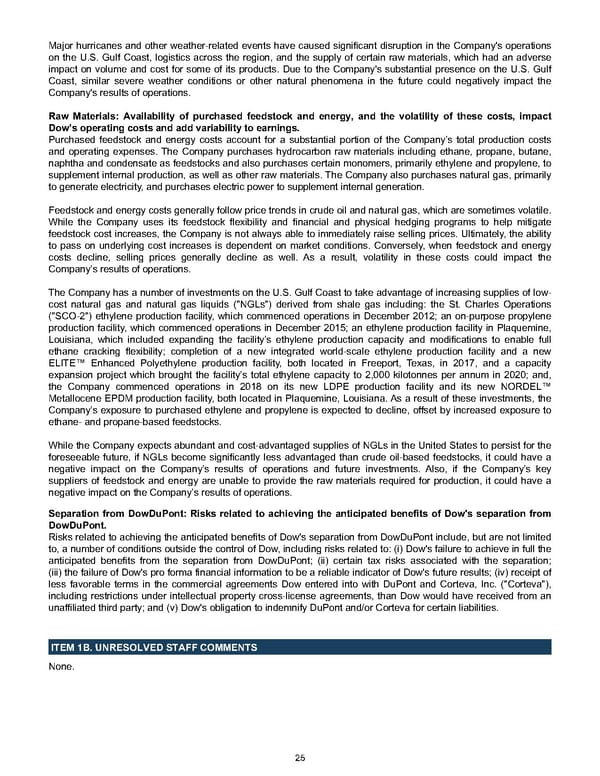Major hurricanes and other weather-related events have caused significant disruption in the Company's operations on the U.S. Gulf Coast, logistics across the region, and the supply of certain raw materials, which had an adverse impact on volume and cost for some of its products. Due to the Company's substantial presence on the U.S. Gulf Coast, similar severe weather conditions or other natural phenomena in the future could negatively impact the Company's results of operations. Raw Materials: Availability of purchased feedstock and energy, and the volatility of these costs, impact Dow’s operating costs and add variability to earnings. Purchased feedstock and energy costs account for a substantial portion of the Company’s total production costs and operating expenses. The Company purchases hydrocarbon raw materials including ethane, propane, butane, naphtha and condensate as feedstocks and also purchases certain monomers, primarily ethylene and propylene, to supplement internal production, as well as other raw materials. The Company also purchases natural gas, primarily to generate electricity, and purchases electric power to supplement internal generation. Feedstock and energy costs generally follow price trends in crude oil and natural gas, which are sometimes volatile. While the Company uses its feedstock flexibility and financial and physical hedging programs to help mitigate feedstock cost increases, the Company is not always able to immediately raise selling prices. Ultimately, the ability to pass on underlying cost increases is dependent on market conditions. Conversely, when feedstock and energy costs decline, selling prices generally decline as well. As a result, volatility in these costs could impact the Company’s results of operations. The Company has a number of investments on the U.S. Gulf Coast to take advantage of increasing supplies of low- cost natural gas and natural gas liquids ("NGLs") derived from shale gas including: the St. Charles Operations ("SCO-2") ethylene production facility, which commenced operations in December 2012; an on-purpose propylene production facility, which commenced operations in December 2015; an ethylene production facility in Plaquemine, Louisiana, which included expanding the facility’s ethylene production capacity and modifications to enable full ethane cracking flexibility; completion of a new integrated world-scale ethylene production facility and a new ELITE™ Enhanced Polyethylene production facility, both located in Freeport, Texas, in 2017, and a capacity expansion project which brought the facility’s total ethylene capacity to 2,000 kilotonnes per annum in 2020; and, the Company commenced operations in 2018 on its new LDPE production facility and its new NORDEL™ Metallocene EPDM production facility, both located in Plaquemine, Louisiana. As a result of these investments, the Company’s exposure to purchased ethylene and propylene is expected to decline, offset by increased exposure to ethane- and propane-based feedstocks. While the Company expects abundant and cost-advantaged supplies of NGLs in the United States to persist for the foreseeable future, if NGLs become significantly less advantaged than crude oil-based feedstocks, it could have a negative impact on the Company’s results of operations and future investments. Also, if the Company’s key suppliers of feedstock and energy are unable to provide the raw materials required for production, it could have a negative impact on the Company’s results of operations. Separation from DowDuPont: Risks related to achieving the anticipated benefits of Dow's separation from DowDuPont. Risks related to achieving the anticipated benefits of Dow's separation from DowDuPont include, but are not limited to, a number of conditions outside the control of Dow, including risks related to: (i) Dow's failure to achieve in full the anticipated benefits from the separation from DowDuPont; (ii) certain tax risks associated with the separation; (iii) the failure of Dow's pro forma financial information to be a reliable indicator of Dow's future results; (iv) receipt of less favorable terms in the commercial agreements Dow entered into with DuPont and Corteva, Inc. ("Corteva"), including restrictions under intellectual property cross-license agreements, than Dow would have received from an unaffiliated third party; and (v) Dow's obligation to indemnify DuPont and/or Corteva for certain liabilities. ITEM 1B. UNRESOLVED STAFF COMMENTS None. 25
 Annual Report Page 34 Page 36
Annual Report Page 34 Page 36